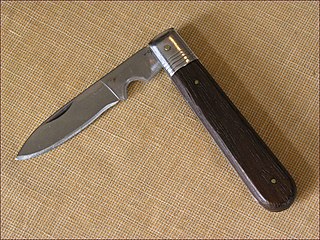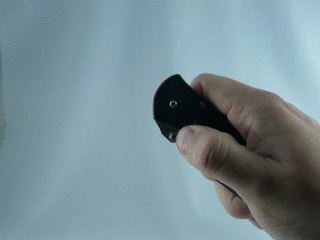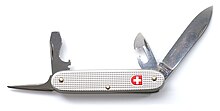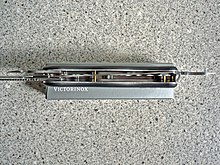
A knife is a tool or weapon with a cutting edge or blade, usually attached to a handle or hilt. One of the earliest tools used by humanity, knives appeared at least 2.5 million years ago, as evidenced by the Oldowan tools. Originally made of wood, bone, and stone, over the centuries, in step with improvements in both metallurgy and manufacturing, knife blades have been made from copper, bronze, iron, steel, ceramic, and titanium. Most modern knives have either fixed or folding blades; blade patterns and styles vary by maker and country of origin.

A switchblade is a pocketknife with a sliding or pivoting blade contained in the handle which is extended automatically by a spring when a button, lever, or switch on the handle or bolster is activated. Virtually all switchblades incorporate a locking blade, where the blade is locked against accidental closure when the blade is in the open position. It is unlocked by a mechanism that allows the blade to be folded and locked in the closed position.

Penknife, or pen knife, is a small folding knife. Today penknife is also the common British English term for both a pocketknife, which can have single or multiple blades, and for multi-tools, with additional tools incorporated into the design.
A gravity knife is a knife with a blade contained in its handle, and that opens its blade through the force of gravity. This mechanism of opening is fundamentally different from the switchblade, which extends its spring-propelled blade automatically upon the push of a button, switch, or fulcrum lever. The main purpose of gravity opening is that it allows opening and closing to be done one handed, in situations where the other hand is occupied. Hence, historically they have been issued to parachutists to cut off caught lines, such as lines tangled in trees, a major potential use of the gravity knife.

The Opinel company has manufactured and marketed a line of eponymous wooden-handled knives since 1890 from its headquarters in Saint-Jean-de-Maurienne, Savoie, France where the family-run company also operates a museum dedicated to its knives. The company sells approximately 15 million knives annually. Opinel knives are made of both high carbon and stainless steel, the latter being Sandvik steel from Sweden.

Buck Knives is an American knife manufacturer founded in Mountain Home, Idaho and now located in Post Falls, Idaho. The company has a long history through five generations of the Buck family from 1902 to the present day. Buck Knives primarily manufactures sport and field knives and is credited with inventing the "folding hunting knife" and popularizing it to such a degree that the term "buck knife" has become synonymous with folding lockback knives, including those made by other manufacturers.

An assisted-opening knife is a type of folding knife which uses an internal mechanism to finish the opening of the blade once the user has partially opened it using a flipper or thumbstud attached to the blade.

Ernest R. Emerson is an American custom knifemaker, martial artist, and edged-weapons expert. Originally an engineer and machinist in the aerospace industry, Emerson became a knifemaker by producing knives for a martial arts class and making art knives early in his knifemaking career. In the 1980s he became better known for his combat knives and popularizing a style of knife known as the Tactical-folder.

Christopher Stanley Reeve is a South African-American knife maker, recognized as one of the most influential people in knife making history. Reeve founded Chris Reeve Knives (CRK) in 1984. In 2014, Reeve retired and was inducted into the Blade Magazine Hall of Fame in 2015.

The Linerlock is a locking mechanism for folding pocket knives. A Linerlock is a folding knife with a side-spring lock that can be opened and closed with one hand without repositioning the knife in the hand. The lock is self-adjusting for wear. The modern Linerlock traces its lineage to the late 19th century, but in the 1980s the design was improved by American custom knifemaker Michael Walker.

The Sebenza is a folding pocket knife manufactured by Chris Reeve Knives of Boise, Idaho. It is constructed with a stainless steel blade and titanium handle. Its handle functions as the lock mechanism similar in concept to the Walker linerlock differing in that the handle itself forms the lock bar which holds the blade open. This mechanism was invented by Chris Reeve, and is called the Reeve Integral Lock (R.I.L). It is also commonly referred to as the Framelock, and is one of the most widely implemented locking systems in the folding knife industry, where lock strength and reliability is a product requirement. The name Sebenza is derived from the Zulu word meaning "Work," a tribute to Mr. Reeve's South African origins.

An OTF Knife, also known as an out-the-front knife, sliding knife, telescoping knife, or angel blade, is a pocketknife with a blade that opens and closes through a hole in one end of the handle. This design contrasts with the majority of utility knives, which are either standard folding knives or are "fixed blade" sheath knives.
Chris Reeve Knives is an American knife manufacturing corporation with international sales and distribution headquartered in Boise, Idaho, that designs, develops, and sells folding pocket knives and fixed-blade knives. Its products include the Sebenza, Inkosi, Umnumzaan, TiLock, Mnandi folding knives, Impinda slip joint, and the Green Beret, Pacific, Professional Soldier, Nyala, and Sikayo fixed blade knives. Chris Reeve Knives' industry contributions include the Integral Lock, contributions to the blade steels CPM-S30V and CPM-S35VN, and has won Blade Magazine's Blade Show Manufacturing Quality Award 15 times. Their motto is Think Twice, Cut Once.

Columbia River Knife & Tool, Inc. (CRKT) is an American knife company established in 1994, and currently based in Tualatin, Oregon, United States. The company's president and sales executive is Rod Bremer and the finance executive is Peggy Bremer.

A higonokami is a type of folding pocket knife originating in Miki, Hyōgo Prefecture, Japan in 1896. The knife has no locking system, but is a friction folder or "penny knife", using the friction of the swivel or the pressure of the user's thumb on its iconic lever or chikiri, to prevent the knife from folding during use. The handle of the Higonokami is made of a folded over sheet of metal. The handle is stamped with the name of the maker of the knife and the steel used in the blade. A distinguishing feature is that the blade has a flat grind without a secondary bevel.

The CQC-6 or Viper Six is a handmade tactical folding knife with a tantō blade manufactured by knifemaker Ernest Emerson. Although initially reported as the sixth design in an evolution of fighting knives and the first model in the lineup of Emerson's Specwar Custom Knives, Emerson later revealed that the knife was named for SEAL Team Six. It has a chisel-ground blade of ATS-34 or 154CM stainless steel and a handle made of titanium and linen micarta. The CQC-6 is credited as the knife that popularized the concept of the tactical folding knife.

Michael Leon Walker is an American custom knifemaker and sculptor based in Taos, New Mexico. Walker is the inventor of more than 20 different knife mechanisms including the Walker Linerlock for which he secured a trademark in 1980.

A fighting knife has a blade designed to most effectively inflict injury in close-quarters physical confrontations. The combat knife and the trench knife are examples of military fighting knives.
Walter Wells "Blackie" Collins was an American knife maker who designed and popularized the assisted opening mechanism and various automatic knife designs within the art of knifemaking. He is cited by other knifemakers and collectors as one of the most innovative knife designers in the world and was an author and the founder of what became Blade Magazine. Collins died July 20, 2011, in a motorcycle accident near North, South Carolina.
Robert G. Terzuola is an American knife maker who popularized the type of knife known as the tactical folding knife.








































